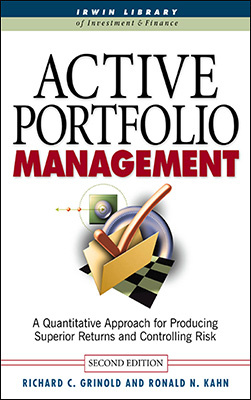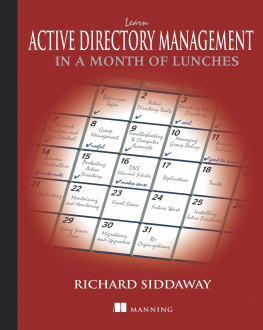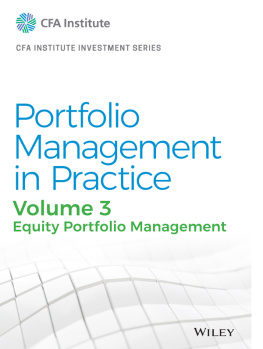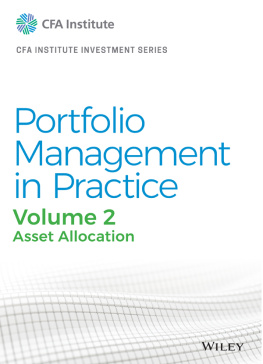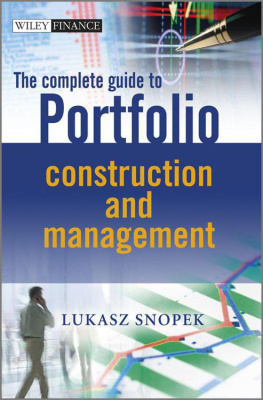Richard C. Grinold - Advances in Active Portfolio Management
Here you can read online Richard C. Grinold - Advances in Active Portfolio Management full text of the book (entire story) in english for free. Download pdf and epub, get meaning, cover and reviews about this ebook. year: 2020, publisher: McGraw-Hill Education, genre: Business. Description of the work, (preface) as well as reviews are available. Best literature library LitArk.com created for fans of good reading and offers a wide selection of genres:
Romance novel
Science fiction
Adventure
Detective
Science
History
Home and family
Prose
Art
Politics
Computer
Non-fiction
Religion
Business
Children
Humor
Choose a favorite category and find really read worthwhile books. Enjoy immersion in the world of imagination, feel the emotions of the characters or learn something new for yourself, make an fascinating discovery.
- Book:Advances in Active Portfolio Management
- Author:
- Publisher:McGraw-Hill Education
- Genre:
- Year:2020
- Rating:3 / 5
- Favourites:Add to favourites
- Your mark:
- 60
- 1
- 2
- 3
- 4
- 5
Advances in Active Portfolio Management: summary, description and annotation
We offer to read an annotation, description, summary or preface (depends on what the author of the book "Advances in Active Portfolio Management" wrote himself). If you haven't found the necessary information about the book — write in the comments, we will try to find it.
Advances in Active Portfolio Management — read online for free the complete book (whole text) full work
Below is the text of the book, divided by pages. System saving the place of the last page read, allows you to conveniently read the book "Advances in Active Portfolio Management" online for free, without having to search again every time where you left off. Put a bookmark, and you can go to the page where you finished reading at any time.
Font size:
Interval:
Bookmark:
If you enjoyed this book, discover your next great read with the following excerpt.
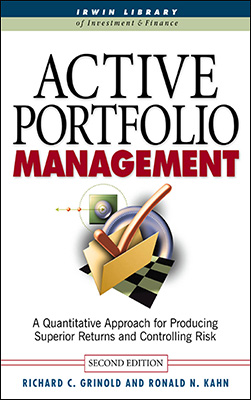
Introduction
The art of investing is evolving into the science of investing. This evolution has been happening slowly and will continue for some time. The direction is clear; the pace varies. As new generations of increasingly scientific investment managers come to the task, they will rely more on analysis, process, and structure than on intuition, advice, and whim. This does not mean that heroic personal investment insights are a thing of the past. It means that managers will increasingly capture and apply those insights in a systematic fashion.
We hope this book will go part of the way toward providing the analytical underpinnings for the new class of active investment managers. We are addressing a fresh topic. Quantitative active managementapplying rigorous analysis and a rigorous process to try to beat the marketis a cousin of the modern study of financial economics. Financial economics is conducted with much vigor at leading universities, safe from any need to deliver investment returns. Indeed, from the perspective of the financial economist, active portfolio management appears to be a mundane consideration, if not an entirely dubious proposition. Modern financial economics, with its theories of market efficiency, inspired the move over the past decade away from active management (trying to beat the market) to passive management (trying to match the market).
This academic view of active management is not monolithic, since the academic cult of market efficiency has split. One group now enthusiastically investigates possible market inefficiencies. Still, a hard core remains dedicated to the notion of efficient markets, although they have become more and more subtle in their defense of the market.1
Thus we can look to the academy for structure and insight, but not for solutions. We will take a pragmatic approach and develop a systematic approach to active management, assuming that this is a worthwhile goal. Worthwhile, but not easy. We remain aware of the great power of markets to keep participants in line. The first necessary ingredient for success in active management is a recognition of the challenge. On this issue, financial economists and quantitative researchers fall into three categories: those who think successful active management is impossible, those who think it is easy, and those who think it is difficult. The first group, however brilliant, is not up to the task. You cannot reach your destination if you don t believe it exists. The second group, those who don t know what they don t know, is actually dangerous. The third group has some perspective and humility. We aspire to belong to that third group, so we will work from that perspective. We will assume that the burden of proof rests on us to demonstrate why a particular strategy will succeed.
We will also try to remember that this is an economic investigation. We are dealing with spotty data. We should expect our models to point us in the correct direction, but not with laserlike accuracy. This reminds us of a paper called Estimation for Dirty Data and Flawed Models.2 We must accept this nonstationary world in which we can never repeat an experiment. We must accept that investing with real money is harder than paper investing, since we actually affect the transaction prices.
We have written this book on two levels. We have aimed the material in the chapters at the MBA who has had a course in investments or the practitioner with a year of experience. The technical appendices at the end of each chapter use mathematics to cover that chapters insights in more detail. These are for the more technically inclined, and could even serve as a gateway to the subject for the mathematician, physicist, or engineer retraining for a career in investments. Beyond its use in teaching the subject to those beginning their careers, we hope the comprehensiveness of the book also makes it a valuable reference for veteran investment professionals.
We have written this book from the perspective of the active manager of institutional assets: defined-benefit plans, defined-contribution plans, endowments, foundations, or mutual funds. Plan sponsors, consultants, broker-dealers, traders, and providers of data and analytics should also find much of interest in the book. Our examples mainly focus on equities, but the analysis applies as well to bonds, currencies, and other asset classes.
Our goal is to provide a structured approacha processfor active investment management. The process includes researching ideas (quantitative or not), forecasting exceptional returns, constructing and implementing portfolios, and observing and refining their performance. Beyond describing this process in considerable depth, we also hope to provide a set of strategic concepts and rules of thumb which broadly guide this process. These concepts and rules contain the intuition behind the process.
As for background, the book borrows from several academic areas. First among these is modern financial economics, which provides the portfolio analysis model. Sharpe and Alexanders book Investments is an excellent introduction to the modern theory of investments. Modern Portfolio Theory, by Rudd and Clasing, describes the concepts of modern financial economics. The appendix of Richard Rolls 1977 paper A Critique of the Asset Pricing Theorys Tests provides an excellent introduction to portfolio analysis. We also borrow ideas from statistics, regression, and optimization.
We like to believe that there are no books covering the same territory as this.
Quantitative active management is the poor relation of modern portfolio theory. It has the power and structure of modern portfolio theory without the legitimacy. Modern portfolio theory brought economics, quantitative methods, and the scientific perspective to the study of investments. Economics, with its powerful emphasis on equilibrium and efficiency, has little to say about successful active management. It is almost a premise of the theory that successful active management is not possible. Yet we will borrow some of the quantitative tools that economists brought to the investigation of investments for our attack on the difficult problem of active management.
We will add something, too: separating the risk forecasting problem from the return forecasting problem. Here professionals are far ahead of academics. Professional services now provide standard and unbiased3 estimates of investment risk. BARRA pioneered these services and has continued to set the standard in terms of innovation and quality in the United States and worldwide. We will review the fundamentals of risk forecasting, and rely heavily on the availability of portfolio risk forecasts.
The modern portfolio theory taught in most MBA programs looks at total risk and total return. The institutional investor in the United States and to an increasing extent worldwide cares about active risk and active return. For that reason, we will concentrate on the more general problem of managing relative to a benchmark. This focus on active management arises for several reasons:
Clients can clump the large number of investment advisers into recognizable categories. With the advisers thus pigeonholed, the client (or consultant) can restrict searches and peer comparisons to pigeons in the same hole.
The benchmark acts as a set of instructions from the fund sponsor, as principal, to the investment manager, as agent. The benchmark defines the managers investment neighborhood. Moves away from the benchmark carry substantial investment and business risk.
Next pageFont size:
Interval:
Bookmark:
Similar books «Advances in Active Portfolio Management»
Look at similar books to Advances in Active Portfolio Management. We have selected literature similar in name and meaning in the hope of providing readers with more options to find new, interesting, not yet read works.
Discussion, reviews of the book Advances in Active Portfolio Management and just readers' own opinions. Leave your comments, write what you think about the work, its meaning or the main characters. Specify what exactly you liked and what you didn't like, and why you think so.

